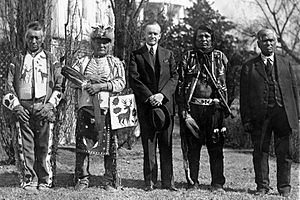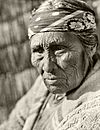Native American recognition in the United States facts for kids

When we talk about American Indian tribal recognition in the United States, it usually means two things. First, it's about a Native American tribe being officially recognized by the United States government. Second, it can mean a person becoming an official member of one of these recognized tribes. Today, there are 574 federally recognized tribal governments in the U.S.
These recognized tribes have the right to govern themselves. This means they can create their own laws, manage their lands, and decide who belongs to their tribe. They have a special relationship with the U.S. government, like one nation to another. However, just like states, tribes cannot declare war or print their own money.
Defining who is "Indian" has been complicated throughout history. Many different laws and government groups have had their own definitions. For example, the American Indian Religious Freedom Act of 1978 says an Indian is someone who belongs to a tribe that receives special programs and services from the U.S. government because of their status as Indians.
Contents
How "Indian" Was Defined in the Past
In the past, courts and laws didn't always agree on how to define who was "Indian." Sometimes, even if a person was a member of a federally recognized tribe, courts might not have seen them as "Indian" for certain legal reasons.
The Major Crimes Act of 1885 said that serious crimes committed by Native Americans in Native American territory would be handled by the federal government. For this law, the government often required a person to be an enrolled member of a tribe.
The Indian Reorganization Act of 1934 was an important law. It defined an Indian based on three things: being a tribal member, having Native American ancestors, or having a certain amount of "Indian blood" (called blood quantum).
In the 1930s, the government used several factors to decide if someone was more than half-blood Indian. These included tribal records, personal stories, statements from people who knew the person, and even studies by anthropologists. One anthropologist, Carl Selzer, used methods that are now seen as unfair and unscientific. For example, he tried to define "Indian" based on physical features, which led to confusing results, like children being called Indian but their parents not.
When Recognition Ended (Termination Era)
In the 1950s and 1960s, the U.S. government had a policy called "termination." It decided that some tribes were strong enough to govern themselves and no longer needed federal help. So, the government ended its special relationship with many tribes, like the Menominees in Wisconsin and the Klamath in Oregon.
Many tribes were against this policy. It caused a lot of problems and "devastated" many groups. For example, the Taylorsville Rancheria tribe lost their land, which was sold for a park. Even though the government didn't officially end their tribe through a law, they were removed from the list of recognized tribes. Many tribes affected by this policy have worked hard to get their recognition back.
New Ways of Defining "Indian"
The U.S. government has changed how it defines "Indian." Instead of using ideas like "blood quantum," which are based on race, it now focuses on "political" definitions. This means that being "Indian" is often defined by being a member of a federally recognized tribe.
This shift started in the 1970s, especially during the Nixon administration. The goal was to let tribes have more control over their own lives and decisions, including who can be a member. President Nixon wanted to help tribes become independent without losing federal support.
A key law was the Indian Self-Determination and Education Assistance Act of 1975. This law began to give tribal governments more power to manage federal programs and funds meant for Native Americans. This change allows tribes to decide what "Indianness" means for their own members.
However, sometimes this can lead to difficult situations. For example, after the Civil War, the U.S. government made a treaty with the Cherokee Nation of Oklahoma that said formerly enslaved people (called Freedmen) could become tribal citizens. But recently, the Cherokee Nation changed its rules, requiring members to show they had at least one Native American ancestor listed on the Dawes Rolls. This meant nearly 2,000 Cherokee Freedmen, whose families had been part of the tribe for generations, were no longer considered members.
The Indian Arts and Crafts Act of 1990 is another important law. It says that only Native Americans can sell their crafts as "Indian made." This law helps protect Native American artists from fake products. It defines an Indian as someone who is a member of an Indian tribe or certified as an Indian artist by a tribe. This definition also includes groups recognized by a state, not just the federal government.
Because there are different legal definitions, a person might be eligible for some benefits, like educational grants, but not others, like health benefits. Some people worry that these legal definitions make "Indianness" a strict legal term, rather than something based on tradition, history, and culture.
Becoming a Recognized Tribe
Gaining federal recognition is a very difficult process for tribes. The Bureau of Indian Affairs (BIA) says that a federally recognized tribe has a special "government-to-government" relationship with the U.S. government. This means they have certain rights, powers, and responsibilities.
There are three main ways a tribe can become federally recognized:
- By an act of Congress (a law passed by the U.S. government).
- Through special administrative procedures set by the BIA.
- By a decision from a U.S. court.
If Congress has already ended a tribe's relationship with the U.S. government, that tribe usually cannot go through the BIA's recognition process. The BIA also publishes a list of all federally recognized tribes every year.
Today, there are 574 federally recognized tribes. Tribes that are already recognized often don't want the process to become too easy for new groups. They worry that more recognized tribes might mean less federal funding and resources for everyone. With the rise of casino gambling, which can bring a lot of money to tribes, more groups are trying to gain federal recognition. For many, gaining recognition is also a way to confirm their identity and heritage.
Before 1978, tribes were recognized through treaties, executive orders, or presidential announcements. The 1934 Indian Reorganization Act also helped some non-recognized tribes become recognized.
In the 1960s and 1970s, many groups that weren't federally recognized started demanding their rights. They wanted their lands back or fishing rights, or simply to be recognized as original peoples. Because federal status allowed groups to make legal claims, many people saw the need for a clearer way to recognize tribes. So, in 1978, the BIA created the Federal Acknowledgment Process, now called the Office of Federal Acknowledgment. This office decides which groups can become recognized.
To be federally recognized, a group must meet certain rules:
- They must have been a clear community since 1900 and from historical times.
- They must have political influence over their members.
- They must have rules for who can be a member.
- Their members must be descendants of a historical Indian tribe and not already enrolled in another tribe.
Blood Quantum and Native American Identity
Over time, the idea of who is "Indian" has been changed by the U.S. government and settler society. Laws about "blood quantum" (how much "Indian blood" someone has) caused problems for Native tribes. These laws made it very hard for many Native Americans to be considered Indigenous, especially after many individuals were removed from tribal rolls.
In the early 1900s, the federal government used blood quantum to deny land to some mixed-race Native Americans. They often required a person to have at least one-quarter Native American blood to receive land. These laws, as Maya Harmon explains, helped "uphold white supremacy and dominance" by controlling who was considered "Native enough."
Recognition for Individuals
The United States Census allows people to choose their ethnicity without needing proof. So, anyone can say they are American Indian or Alaska Native on the census. In 1990, about 1.8 million people identified as American Indian, but only about 60% of them were enrolled in federally recognized tribes.
People who identify as Indian but are not part of a recognized tribe often want to join one. However, the tribe's government usually has the final say on who can be a member. Holly Reckord, who works for the BIA, says that many people who seek membership don't have any Native American ancestry, but they are still convinced they are Indian. It's a complex issue why so many people want to identify as Indian today.
Federally recognized tribes have seen their membership numbers grow. This is partly because more people are interested in Native American heritage and culture.
Disenrollment
Disenrollment is when a Native American person loses their official membership with a tribe. If a Native person is disenrolled, they can lose government benefits and their status as a member of a federally recognized tribe. It can also deeply affect their identity.
For example, the Nooksack tribe disenrolled nearly 300 members. This long process stripped many people of their tribal citizenship. Some believe that disenrollment aims to weaken Native tribes and make it harder for individuals to gain or keep recognition as Native Americans.
Sometimes, a person might be removed from a tribe for serious reasons, or if it's found that their claim to membership was not correct. However, many disenrollments, especially by smaller tribes with casino income, have raised concerns. Several Native American communities have now banned disenrollment.
Examples of Disenrollment Cases
- Black Seminoles
- Cahto Tribe Rancheria: Disenrolled 33% of members after their casino opened in 1995.
- Cherokee freedmen controversy: This involves the descendants of formerly enslaved people who were part of the Cherokee Nation.
- Chitimacha tribe of Louisiana: Between 1904 and 1919, people of mixed African and Native American ancestry were removed from the tribe.
- Confederated Tribes of the Grand Ronde: In 2013, 86 descendants were disenrolled, but this decision was later reversed in 2016.
- Hopland Band of Pomo Indians: 74 members were disenrolled due to "errors" in their applications.
- Nooksack: 306 members were disenrolled.
- Omaha Tribe of Nebraska: 15 members disenrolled based on blood quantum.
- Pala Band of Mission Indians: 154 members disenrolled in total.
- Pechanga: 236 members disenrolled.
In 2016, a website called "Stop Disenrollment" was created by Native Peoples. By 2020, it was estimated that nearly 10,000 members from 85 tribes had been disenrolled over 15 years.
State-Recognized Tribes
Gaining federal recognition is very challenging for most Native tribes. However, some tribes have been recognized by individual states. This means these tribes are officially recognized by a state government for various state purposes.
For example, in 1924, Virginia passed the Racial Integrity Act. This law made it very difficult for Native Americans in Virginia to be recognized, as it only recognized "colored" and "white" people. This act has made it nearly impossible for these tribes to gain recognition in the future.
Some groups that are not federally recognized have still achieved state recognition. Many states, especially in the East, have their own recognition process separate from the federal one. Examples include the Lumbee Tribe of North Carolina and the Houma Tribe of Louisiana.



